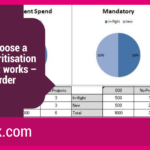There will always be plenty of projects for your project management office (PMO) to sink its teeth into and push through the business. In a growing PMO or one that needs a prioritisation revamp, you need to choose a project prioritisation process that works, with weighted scoring being an option.
Every PMO needs to know how to set project priorities to ensure that the projects that will return the most value get delivered first. There is now PMO with unlimited resources, so you and your team need to know how best to allocate the people, time, money, and tools you have to get results.
We’ve already looked at the simple and easy to use prioritisation process of rank order, and in this blog post, we’re going to explore the more detailed method of weighted scoring, covering:
- What weighted scoring prioritisation is
- How to create a weight scoring project prioritisation process
- The pros and cons of weighted scoring for your PMO process
To help you determine if this process will be the right fit for your office.
What is weighted scoring for project prioritisation?
Weighted scoring is a method to prioritise the projects in your PMO that recognises a range of factors and gives each a different level of importance.
It’s a relatively easy way for you to determine the risks and the value of each project that falls under your office. The process is easily repeatable, meaning you can run it at the project intake stage and again when it comes to re-evaluating your projects, whether that’s quarterly, or half-yearly for example.
Running weighted scoring shouldn’t require too much work – one person or a small cohort should be able to complete the work reasonably simply. This will depend on how many criteria you build into your weighted scoring process, though.
Although there is an element of opinion that goes into the scores, by having a range of people complete the same task, you can take an average of the outputs to give your projects priority.
How do I create a weighted scoring project prioritisation process?
To design a weighted scoring prioritisation process, there are a few simple steps that you need to follow:
- Determine a list of categories that you’ll score your projects on, such as financial returns, ROI, customer impact, and strategic alignment – work with your PMO and project KPIs to see what to focus on.
- Give each category a weighting based on how important it is to your PMO and the wider business. Again this should be led by your KPIs and the overall business goals.
- Choose how you will score each criterion; usually this would be number 1-5 or 1-10, but you may choose a simpler low, medium, and high depending on the process users.
- Decide which areas will be asked to complete the process each time to ensure that a range of interests across the business are represented during the process. You may decide to weight these inputs as well.
- Test your prioritisation model against a collection of completed projects to check that your categories and their weightings would have produced the outputs you’d expect.
What are the advantages and disadvantages of using weighted scoring for your project prioritisation process?
Pros of using weighted scoring project prioritisation
- It’s relatively easy to use, so not much training is required when asking different business areas to complete it.
- It allows you to focus on different areas such as risk or strategy, and you can adapt the focus over time.
- The outcome is simple – just a numerical value – making it easy to present to the business.
- Your PMO can easily repeat the process for ongoing prioritisation assessments.
Cons of using weighted scoring project prioritisation
- It doesn’t account well for resource requirements and focuses on outcomes.
- There can be a large workload and timeline when you involve lots of business areas.
- It’s not as suitable for mature PMOs with a broad project intake.
- You’ll need to bring in software or have a database designed.
The take-home
When choosing a project prioritisation process that works, weighted scoring is useful for a PMO that’s established and has a range of projects but within the same business area. It is more detailed than using rank order and should provide more accurate outcomes.
Be sure that you repeat the process regularly since projects and priorities change as the business progresses.






